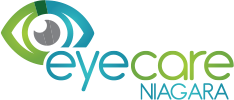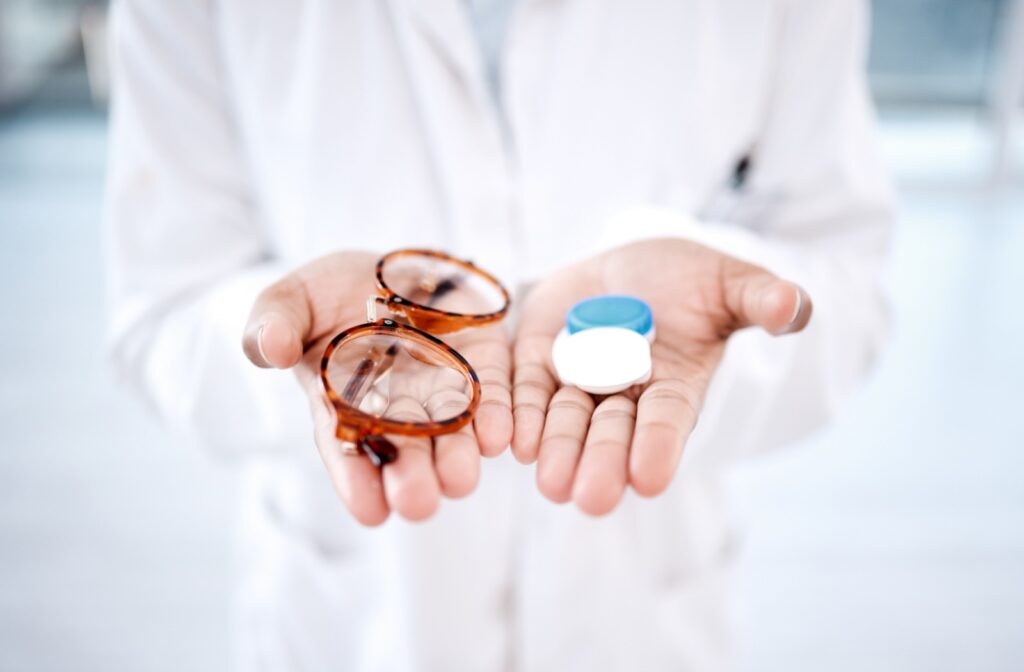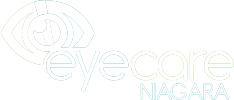Switching from eyeglasses to contact lenses can offer a world of convenience and comfort. Contacts offer an incredible alternative to glasses. However, making this switch has a learning curve for first-time wearers. Questions such as whether you can convert your eyeglass prescription to a contact lens prescription often arise.
While several mathematical formulas claim to help you estimate a contact lens prescription, these don’t give you an exact conversion. Instead, you’ll need to visit your optometrist for a contact lens fitting and exam. This ensures a proper fit and clarity for your unique visual needs.
We’ll explore the differences between contact lenses and eyeglass prescriptions ahead, along with other measurements needed to ensure you find a comfortable fit.
Are Contact Lens & Eyeglass Prescriptions the Same?
There’s a key difference in eyeglass and contact lens prescriptions, and it all has to do with distance. When a lens changes distance from your eye, it’s much less effective—think of the last time you used a magnifying glass. Holding the magnifying glass just a finger-width closer suddenly makes everything appear blurry.
Now think about corrective lenses. While eyeglasses rest a small distance from your eye—usually around 12 millimetres or so—contacts rest directly on your cornea. This distance may seem small, but the effect it has is massive.
Because of this, your glasses and contact prescription will always be different. You’ll need a professional’s help to get an accurate contact lens prescription.
How Eyeglass Prescriptions Are Measured
To get your eyeglass prescription, you’ll need to book a comprehensive eye exam first. During the exam, your optometrist will assess your eye health, determine your unique prescription, and look for any underlying conditions affecting your eyes and vision.
Several factors determine eyeglass prescriptions. These include:
- The needed lens power
- The distance between your pupils and the lens
- Magnification
- Corneal conditions like astigmatism
These measurements are then used to determine the specific strength of your future lens. This is written as something called “diopters,” the numbers you eventually see when handed your prescription. For example, if your prescription reads “-2.00”, you need 2 diopters of strength in a lens to correct near vision. The higher this number is, the stronger you need your lenses to be.
How Contact Lens Prescriptions Are Measured
Contact lens prescriptions, on the other hand, include some additional parameters. Remember—these don’t just have to give you clear vision. They need to do so while touching your eye and staying in place. This can lead to a more complex prescription.
Your optician will use the same measurements as with eyeglasses, but they’ll also measure:
- The curvature of the contact lens, which should match the curvature of your eye.
- The size of the contact lens, which affects how it sits on your eye.
- Any existing corneal conditions that could affect the lens.
- The lens power needed for correcting vision.
These parameters are essential for ensuring the contact lens fits well and provides optimal vision correction. Then, your optometrist needs to consider what materials are ideal for you. While some lenses are rigid, others are softer and more malleable. All of these factors need to be taken into account before you get your lenses.

How to Get Your Contact Lens Prescription
If you’re thinking about trying contact lenses, your first step is to visit your optometrist for a contact lens fitting and exam. This lets your optometrist determine your specific needs and provide you with a contact lens prescription. During this fitting, your optometrist will also teach you how to properly insert, remove, and care for your lenses.
There are several key steps here:
- We will assess your overall eye health during a comprehensive exam.
- We’ll determine your prescription through a series of non-invasive tests.
- We’ll carefully measure your eyes and map your cornea to determine the right size, shape, and brand of contacts for you.
- We’ll send you home with a trial pair of contacts.
This trial pair will match the exact prescription, type, and brand used for your future lenses. You’ll wear these as needed and return for a follow-up appointment a few days later to let us know about your experience. If any adjustments are required, we can make them.
At the end of the day, the goal is to get you a pair of properly fitting contacts that meet your unique needs. Our team is here to help, and if you have any questions, feel free to ask. Your comfort and convenience are a top priority.
Get Your New Contact Lens Prescription
If you’re considering contact lenses as an alternative to your eyeglasses, our team at EyeCare Niagara is ready to help. You deserve clear, comfortable vision, and it’s well within reach. Book your contact lens fitting and exam with us today, and let our team help you find a solution!




